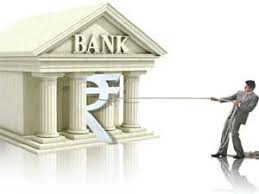
Deccan HeraldC S Krishnamurthy, Aug 13, 2014
The Central Bureau of Investigation (CBI) recently arrested Syndicate Bank Chairman and Managing Director (CMD), Sudhir Kumar Jain and others for indulging in corruption over extending credit favours.
A report citing Jain, accused of taking Rs 50 lakh bribe, disturbed the conscience of the “faithful and friendly” Manipal-based bank.
The difficulties in the task of detecting internal frauds were realised ages ago. The problem continues to be difficult and Sudhir Kumar Jain reminds us of that. The sum of Rs 50 lakh seem small given the powers vested in the CMD. While the list of bank frauds is a long one, one can’t miss out the Ex-Indian Bank CMD M Gopalakrishnan who was sentenced to one-year rigorous imprisonment for allegedly causing a loss of over Rs 30 crore to the bank for approving loans without proper security between 1992-1996, and was subsequently found guilty of conspiracy, criminal breach of trust, misconduct and cheating under various provisions of IPC and Prevention of Corruption Act.
While money and crime are made for each other, this appears only a tip of the iceberg. A wider net might reveal larger cupboards across more banks. If the loan is huge, probe if any “consortium” racket is in play. Leading banks like SBI, PNB and others have led the major consortium advances to top borrowers in the country. Frauds are said to be happening in corporate loans. Beyond financial losses, fraud has other negative consequences that impact an institution’s reputation, customer loyalty and the confidence of the shareholder.
CBI sources reportedly said that Jain “has allegedly taken Rs 50 lakh as bribe from Bhushan Steel for not declaring loans of nearly Rs 100 crore as Non-Performing Assets (NPAs).” NPA refers to bank loans, where the borrower has failed to make interest or principal payments for 90 days. The share-holders should also wake up. Jain has apparently taken unfair advantage of his position through manipulation and abuse of privileged data. He has allegedly given approvals beyond his bounds, for a price.
How safe is it to trust the RBI figures about the NPAs, the virus affecting the banking sector, in the context of willful manipulation of figures? Are the profits shown in the financials true and correct? Recall the infamous Satyam scam, where the Indian arm of PricewaterCoopers, the statutory auditor was fined US$ 6 m by the US Securities and Exchange Commission for not following the code of conduct and auditing standards. Also to be verified is if the internal and external auditors were controlled by the CMD.
Why employees defraud?
Why do employees defraud? Is it an opportunity or attitude? The underlining issue that is being troubled is trust, which is believed to be inherent in our nature, and in the operation of banks. Indeed, higher level officials, motivated by greed, have more power, greater access and less likely to be controlled.
Largely hidden, employee fraud isn’t exactly something banks want to talk about, as they don’t want the public to lose confidence in their institution. It happens, generating huge losses. Tellers, managers, executives… they all have a chance to embezzle. Banksters, who can be found at every level of an organisation, have the potential to swindle the customers, tarnish the reputation and demoralise good co-workers. As a few executives have misled from the front, every time a new official takes over is looked upon with suspicion. Studies have, time and again, identified willful defaults, frauds, mismanagement and misappropriation of funds as primary reasons for the mounting NPAs. Its impact: the whole machinery would be preoccupied with recovery procedures, rather than focusing on expanding business.
I am aware of a dispatch clerk in a public-sector bank, about three decades ago, using two stamped-envelopes separately for the same destination, instead of one. Despite pleading “oversight”, the management charged him with “negligence and causing extra expenditure for the bank”, and postponed his increment by six months, for the “extra expenditure” of 20 paise. The higher the grade, the harsher must be the punishment. Else, there is little difference between a juvenile crime and a “qualified executive” crime. The penalty for the “executive” betrayers should be firm and fair.
Why such stories repeat in PSU banks?
It is possible there is a lack of monitoring of warning signals at state-run banks. Who is to oversee RBI’s vigilance? Bank’s Board of Directors are expected to select competent executives, effectively supervise the bank’s affairs, adopt and follow sound policies and objectives, avoid self-serving practices and observe banking rules and regulations. Interestingly, there are officers/employee nominees on the Board. Even their agitation questioning the irregularities of the banking system can be more specific, well-directed, than a touch-and-go exercise.
The need for a code of conduct has recently been echoed by C H Venkatachalam, general secretary, All India Bank Employees’ Association: "It is high time the government frames a set of rules and conduct regulations applicable to EDs (executive directors) and CMDs. It is all the more necessary because banks deal with huge public money and important financial decisions are taken by them.” Banks should design fraud awareness training programmes for all levels, while the vigilant teams in each bank should be strengthened with the right skills and right officials. Can we expect the Modi-led government that has promised to establish a system which eliminates the scope for corruption through public awareness and making it transparent?

